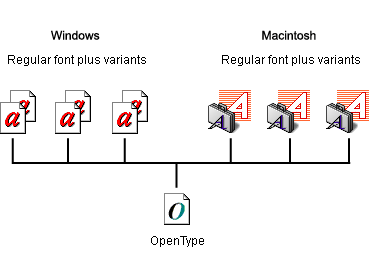

Let’s flesh things out by looking at three of the most common additions to OTF packages. Those that actually use these will typically do so in the Adobe Creative Suite, and for the sole purpose of making subtle tweaks that make text look better for print or on the web. You can’t, for example, just decide to use a different version of an “F” in Facebook or embellish common connecting letters like “TH” to make them look like ornate typography. In other words, for all intents and purposes, OTF is indeed the “better” of the two due to the additional features and options, but for the average computer user, those differences don’t really matter. OTF features embellishments like ligatures and alternate characters - also known as glyphs - that exist to give designers more options to work with.įor most of us non-designers, the additional options will likely go unused. TTF: The Big Differencesįor designers, both amateur and professional, the main useful difference between OTF and TTF is in the advanced typesetting features. With OTF, they could reside in the same file as the default typeface and remain easily accessible to designers and the like. Previously, these additions had to be added as additional fonts using TTF. Since the format offered additional storage for characters that far exceeded the number of characters that the average user would ever need, designers had the ability to add extras like: However, this was especially beneficial to font designers. Obviously there are only 26 characters in the alphabet (A-Z), 10 numbers (0-9) and a handful of extras, like punctuation, currency signs, and various others etc.). For example, OTF featured a format that allowed for the storage of up to 65,000 characters. OTF extended TTF by offering many capabilities that the latter wasn’t capable of providing. Much like TTF, OTF was cross-platform and included the display and printer font data in a single package, but that’s where the similarities end. OTF was also a joint effort, except this time between Adobe and Microsoft.
Fonts otf vs ttf install#
This made it easy to install new fonts and served as an early cross-platform font format that was usable by most consumer devices.

The package containing the font included both the screen and the printer font data in a single file.
Fonts otf vs ttf mac#
The purpose was simple: they needed a format that both Windows and Mac could use natively, as well as a format that could be read by default by most printers. TTF was a joint effort by Apple and Microsoft in the early 1980s.

Well, that’s not entirely true, as PostScript pre-dated it by several years, but it’s not incredibly common today, so we’re going to skip it for the sake of relevance. We’ll start with TTF because it came first. Today, we’re going to sit down and analyze some of the key differences between OTF and TTF fonts, and we’ll help you not only discover the differences, but which is better, and when it’s appropriate to use one over the other.
Fonts otf vs ttf download#
If you’ve ever played around with typefaces or fonts, chances are you’ve asked yourself “What’s the difference between OTF and TTF?” when deciding to download fonts for your system. Why is something as simple as a few pixels on the screen so complicated?įear not, we’ve got you covered.


 0 kommentar(er)
0 kommentar(er)
